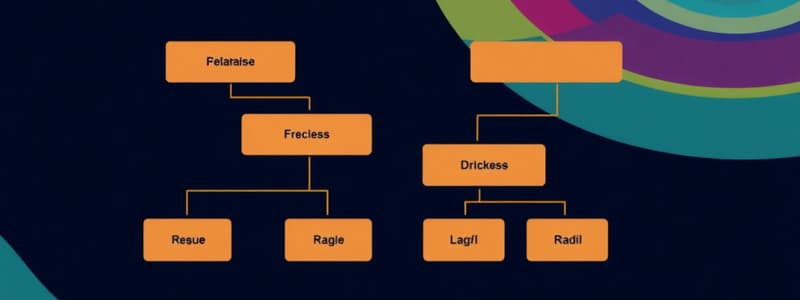Podcast
Questions and Answers
What role do primary keys play in a relational database?
What role do primary keys play in a relational database?
- They serve as a reference point for foreign keys.
- They establish a link between two separate tables.
- They uniquely identify each row within a single table. (correct)
- They prevent data redundancy by merging tables.
Why are foreign key constraints important in a relational database?
Why are foreign key constraints important in a relational database?
- They enable quick retrieval of data across multiple tables.
- They define the structure of tables effectively.
- They ensure that all data entered is accurate and valid. (correct)
- They eliminate the need for primary keys.
Which statement about relationships in relational databases is true?
Which statement about relationships in relational databases is true?
- Relationships are essential for linking tables and maintaining data integrity. (correct)
- Relationships can exist independently of primary and foreign keys.
- Relationships allow for data duplication across tables.
- Relationships reduce the complexity of data retrieval.
How do entity relationship diagrams (ER diagrams) contribute to understanding relational databases?
How do entity relationship diagrams (ER diagrams) contribute to understanding relational databases?
What is one of the benefits of reducing data redundancy in a relational database?
What is one of the benefits of reducing data redundancy in a relational database?
Which of these best describes an entity in the context of a relational database?
Which of these best describes an entity in the context of a relational database?
What does effective data retrieval in a relational database facilitate?
What does effective data retrieval in a relational database facilitate?
What is a key characteristic of a relational database's tables?
What is a key characteristic of a relational database's tables?
What is the goal of normalization in database design?
What is the goal of normalization in database design?
Which statement accurately describes a many-to-many relationship?
Which statement accurately describes a many-to-many relationship?
In an ER diagram, how is a relationship represented?
In an ER diagram, how is a relationship represented?
What does the first normal form ensure about the columns in a database?
What does the first normal form ensure about the columns in a database?
Which step is NOT part of the ER model creation process?
Which step is NOT part of the ER model creation process?
What is a primary key's main function in database design?
What is a primary key's main function in database design?
Which of the following describes the physical implementation phase in database design?
Which of the following describes the physical implementation phase in database design?
What aspect does performance optimization in database design focus on?
What aspect does performance optimization in database design focus on?
Flashcards
One to One Relationship
One to One Relationship
A type of relationship between entities where one entity is associated with exactly one other entity.
One to Many Relationship
One to Many Relationship
A type of relationship between entities where one entity can be associated with multiple instances of another entity.
Many to One Relationship
Many to One Relationship
A type of relationship between entities where multiple instances of one entity can be associated with a single instance of another entity.
Many to Many Relationship
Many to Many Relationship
Signup and view all the flashcards
Normalization
Normalization
Signup and view all the flashcards
1st Normal Form (1NF)
1st Normal Form (1NF)
Signup and view all the flashcards
2nd Normal Form (2NF)
2nd Normal Form (2NF)
Signup and view all the flashcards
3rd Normal Form (3NF)
3rd Normal Form (3NF)
Signup and view all the flashcards
Relational Database
Relational Database
Signup and view all the flashcards
Table
Table
Signup and view all the flashcards
Primary Key
Primary Key
Signup and view all the flashcards
Foreign Key
Foreign Key
Signup and view all the flashcards
Data Integrity
Data Integrity
Signup and view all the flashcards
Efficient Data Retrieval
Efficient Data Retrieval
Signup and view all the flashcards
Reduced Data Redundancy
Reduced Data Redundancy
Signup and view all the flashcards
Entity Relationship Diagram (ERD)
Entity Relationship Diagram (ERD)
Signup and view all the flashcards
Study Notes
Relational Databases
- Relational databases store and access related data points.
- Data is organized into tables consisting of rows (records) and columns (fields).
- Each table represents a specific entity.
- Tables have unique names and contain attributes (columns) and data instances (rows).
Relationships
- Essential for linking tables and ensuring data integrity.
- Established through keys:
- Primary keys uniquely identify each row in a table.
- Foreign keys uniquely identify rows in another table, linking them.
- Data integrity is maintained through relationships.
- Foreign keys prevent invalid data insertion (e.g., preventing an order referencing a non-existent customer).
- Complex queries can retrieve related data across multiple tables (e.g., joining Customer and Order tables).
- Reducing redundant data is helped by storing related data in separate tables (e.g., customer details in a separate table referencing orders).
Entity Relationship Diagrams (ERDs)
- ER diagrams help identify entities, attributes, and relationships.
- Entities are represented as rectangles.
- Attributes are represented as ovals.
- Relationships are represented as diamonds.
Normalization
- Data organization methods to avoid redundancy and ensure accuracy.
- Eliminates redundancy by using primary and foreign keys.
- Reduces transitive dependencies for data integrity.
Database Design
- Creating the structure for storing, accessing, and managing database information.
- Defines tables, fields, data types, and relationships.
- Normalization ensures data structure minimizes redundancy, ensuring data integrity & optimizes data usage.
- Physical Implementation defines database storage and access.
- Performance optimization enhances database speed through indexing, partitioning and query optimization.
Studying That Suits You
Use AI to generate personalized quizzes and flashcards to suit your learning preferences.
Related Documents
Description
This quiz covers the fundamentals of relational databases, including the structure of tables, relationships between entities, and the concept of keys. Test your knowledge on how data integrity is maintained through primary and foreign keys, as well as the use of Entity Relationship Diagrams (ERDs) in designing database systems.




